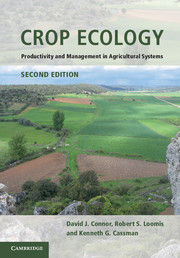Book contents
- Frontmatter
- Contents
- Preface
- Part I Farming systems and their biological components
- Part II Physical and chemical environments
- Part III Production processes
- 8 Nitrogen processes
- 9 Water relations
- 10 Photosynthesis
- 11 Respiration and partitioning
- Part IV Resource management
- Part V Farming past, present, and future
- Species list
- Conversions and constants useful in crop ecology
- References
- Index
11 - Respiration and partitioning
Published online by Cambridge University Press: 05 June 2012
- Frontmatter
- Contents
- Preface
- Part I Farming systems and their biological components
- Part II Physical and chemical environments
- Part III Production processes
- 8 Nitrogen processes
- 9 Water relations
- 10 Photosynthesis
- 11 Respiration and partitioning
- Part IV Resource management
- Part V Farming past, present, and future
- Species list
- Conversions and constants useful in crop ecology
- References
- Index
Summary
Assimilates from photosynthesis serve as substrates for respiration and growth. Sucrose is the principal transport form in crop plants and sucrose and starch are the main storage forms. Assimilates are consumed in respiration providing energy to maintain cellular processes and also for biosynthesis of new materials. It is the partition of those materials, also originating from the same pool of assimilates, that changes the size and morphology of plants during a growing season. This is evident in the changing numbers of stems, leaves, and reproductive structures and its control is an objective of crop production. Here we begin the discussion of partitioning with assimilate use in respiration and biosynthesis.
Carbon use in respiration and synthesis
Respiration furnishes energy for new construction and for maintenance of existing structures. The portion linked with growth is termed growth respiration, Rg. The magnitude of Rg varies with the chemical nature of newly constructed biomass. Maintenance respiration, Rm, also depends on tissue composition and has precedence over growth for assimilate; together Rm and Rg ordinarily consume 30 to 50% of gross photosynthesis. Respiration and chemical composition of new biomass, then, are important aspects of carbon partitioning.
The respiratory process
Respiration occurs in the mitochondria of all living cells and is termed “mitochondrial” or “dark” respiration, thus avoiding confusion with photorespiration (Section 10.1.2). Carbon enters mitochondria as organic acids derived in the cytosol from protein, carbohydrate, or lipid. Within mitochrondria, the tricarboxylic acid (TCA) cycle and electron transport chain accomplish the chemical transformations.
- Type
- Chapter
- Information
- Crop EcologyProductivity and Management in Agricultural Systems, pp. 292 - 320Publisher: Cambridge University PressPrint publication year: 2011
- 1
- Cited by

